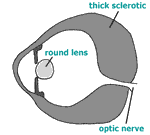 |

 Internal Structure of the Head (Click for larger version)  The Cetacean Eye (Click for larger version)
|
HeadThe head of the dolphin has many interesting features. The face of a dolphin is rather unexpressive. Dolphins seem to wear a permanent smile, but this is deceptive since the head, like the rest of the body, carries significant blubber under the skin. Blubber prevents major muscles on the face to reach the surface. Therefore, dolphins are capable of only a limited range of facial expressions.
Like all mammals, dolphins have to go the surface to breathe. During the course of evolution, the nostrils have moved to the top of the head and is now known as the 'blowhole'. The blowhole is situated behind the melon, in the center of the top of the head, for easy breathing at the surface. In most species of dolphins, the blowhole is crescent-shaped, with the curve towards the back. The hole is naturally closed and must be opened by muscular action. It opens briefly for a fast exhalation and inhalation. There are air sacs under the blowhole which help in the closing of the hole and are also used for sound-formation.
The ear of the dolphin is hardly visible as there is no flaps or lobes, with only a pinhole opening on either side of the head and just behind the eye. Instead of using the ear, a dolphin makes use of a highly developed acoustic faculty to hear sounds with high frequencies between 75 Hz and 150 kHz. The optimum sensitivity of the dolphins for sounds is between 40 and 70 kHz. The well developed acoustic ability is attributed to the auditory system found in the brain of a dolphin. The auditory system of dolphins is more strongly developed than the auditory system of humans, as seen in the fact that the dolphin auditory nerve has double the amount of nerve fibres compared to the human auditory nerve. Sound is transmitted to the dolphin's middle ear via the blubber and the lower jaw. Blubber is mainly fats and the lower jaw is filled with fatty tissues. Since fats can conduct sound well, both the blubber and the lower jaw are good conductors of sound. The dolphins have middle ear cavities that are independently suspended and surrounded by air-filled spaces, reducing the contact with the bones. This probably helps in directional hearing. The middle ear functions to stiffen the sound transmission system, optimising it for high frequencies and also helps to balance the pressure between the inner ear and the external environment.
Dolphins have two eyes - one on each side of the head. Their eyes are built with a jelly-like substance that looks like tears. This mucus like substance protects the eyes from seawater and prevents irritation of the eyes. Their eyes function independently of each other and there are no eyebrows or lashes. Light penetration is poor in water and the importance of sight varies between species and their particular habitats. Generally, dolphins can see well both in and out of the water. However, the eyes of the dolphins are optimized for underwater vision. Unlike the human eye that loses its refractive power under the water, the dolphin eye has very great refractive power because the lens is located further up and is completely spherical, facilitating underwater vision. Because of this, the dolphin eye looks a lot like a fish eye. Instead of having an iris, the dolphin pupil uses a kind of "lid" called operulum that slides down, covering the centre of the pupil under bright light conditions. This action will leave narrow slits on the pupil's edges and these slits can give the dolphin better vision. The dolphin cornea is somewhat different from the usual mammal eyes. The dolphin cornea have two yellow spots (the area on the retina where light-sensitivity is the highest). One of the yellow spots is believed to be used for forward vision and the other for lateral vision.
On the back of the upper jaw, and on the dolphin's top lip, is the bulbous 'melon', a fatty substance used to focus echolocation clicks. The melon serves as an acoustical lens and focuses the clicks into a narrow beam.
Some dolphins have a prominent bird-like beak, known as the rostrum, in front of the eyes, and others do not. The rostrum, which is very hard, is the dolphin's nose or snout. It is not used for smelling but for digging and attacking enemies. | |||||||||
|
BibliographyHarrison, Sir Richard, et. al. Whales, Dolphins and Porpoises. New York: Facts on File, Inc., 1994. Mark Carwardine, The Book of Dolphins. Dragon's World Ltd, 1996 Tursi. "Tursi's Dolphin Page" Available http://www.neteng.bc.ca/~tursi/dolphins/index.htm, 4 September 1997, Accessed 4 April 1998 |
|
© 1998 Thinkquest Team 17963 <17963@advanced.org Modified: 14 July 1998, Created: 30 June 1998 |
